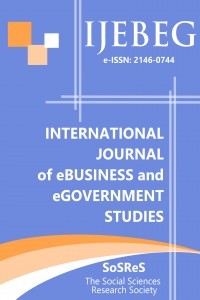APPLICATION OF INFORMATICS TECHNOLOGIES INTO CUSTOMS: ORIGIN AND TARIFF CODE DIVERSION, IMPACTS AND IDENTIFICATION PROBLEM
APPLICATION OF INFORMATICS TECHNOLOGIES INTO CUSTOMS: ORIGIN AND TARIFF CODE DIVERSION, IMPACTS AND IDENTIFICATION PROBLEM
Tariff Code Diversion, Origin Diversion, Customs Risk Analysis, Fraud Detection,
___
- Aliye Ozturk (2005), “Risk Analysis Techniques at Import, Export and Customs
- Crimes” Expertise Thesis 110. Ankara: Undersecretariat of Customs. Clifton Phua, Vincent Lee, Kate Smith, Ross Gayler (2005), “A Comprehensive
- Survey of Data Mining–based Fraud Detection Research”, Cornell University Library Luciano A. Digiampietri, Norton Trevisan Roman, Luis A. A. Meira, Jorge Jambeiro Filho, Cristiano D. Ferreira and Andreia A. Kondo (2008), “Uses of
- Artificial Intelligence in the Brazilian Customs Fraud Detection System”, Proc. of th International Digital Government Research Conference, pp.181-187. Mohd Afandi Md Amin (2010) “Measuring the performance of Customs
- Information Systems (CIS) in Malaysia”, World Customs Journal, Vol. 4, No. 2, pp. 89–104. Norton T. Roman, Cristiano D. Ferreira, Luis A. A. Meira, Rodrigo Rezende, Luciano A. Digiampietri and Jorge Jambeiro Filho (2009), “Attribute-Value
- Specification in Customs Fraud Detection”, Proc. of 10th International Digital Government Research Conference, pp.264-271. Nurcan Ozyazici (2009). “e-Customs”, International Conference on eGovernment: Sharing Experiences, Antalya
- Shao Hua, Zhao Hong and Chang Gui-Ran (2002). “Applying Data Mining to
- Detect Fraud Behavior in Customs Declaration”, Proc. of 1st International Conference on Machine Learning and Cybernetics, pp. 1241-1244.
- UNCTAD and World Customs Organization (WCO) (2008), Technical Note No:
- Risk management in Customs procedures, http://r0.unctad.org/ttl/technical- notes/TN12_RiskManagement.pdf, [Accessed 29.03.2011]
- Başlangıç: 2009
- Yayıncı: Sosyal Bilimler Araştırmaları Derneği
REFERENDUMS AND E-VOTING IN TURKEY
Rabia Bahar ÜSTE, Berrin GÜZEL
MAPPING THE CYCLES-KNOWLEDGE MANAGEMENT AND E-GOVERNMENT
THE MANAGEMENT'S ROLE IN THE SUCCESS OF THE INTRODUCTION OF MANAGEMENT INFORMATION SYSTEMS
Krisztián Kisari, József Csernák, Zoltán Zörög, István Takács
Ahmet Ozturk, Koray Umit, Ihsan Tolga Medeni, Burak Ucuncu, Meryem Caylan, Firat Akba, Tunc Durmus Medeni
Burcu Bastabak, Tunc Durmus Medeni
APPLYING MOBILE TECHNOLOGIES FOR PERSONNEL RECRUITING –AN ANALYSIS OF USER-SIDED ACCEPTANCE FACTORS
Susanne J. NİKLAS, Stephan BÖHM
Mustafa SAĞSAN, Şerife EYÜPOĞLU, Tülen SANER
A CASE STUDY FOR TURKEY: A SECURE PAPER-BASED ELECTRONIC VOTING SYSTEM
Oktay Adalier, Fatih Birinci, Süleyman KARDAŞ, Mehmet Sabır KİRAZ
Muhajir Kachwamba, Iddi Makombe
TACIT KNOWLEDGE EXTRACTION FOR SOFTWARE REQUIREMENT SPECIFICATION
